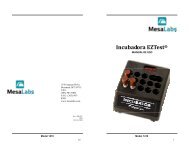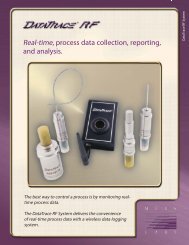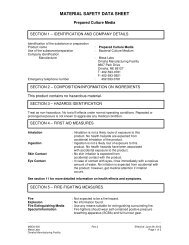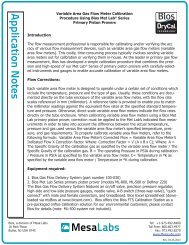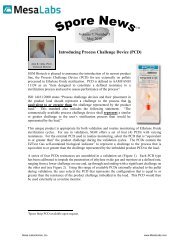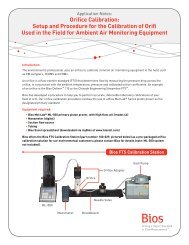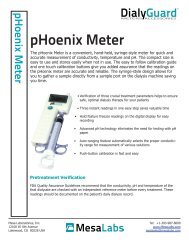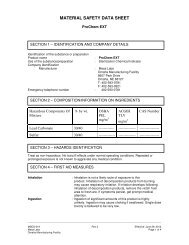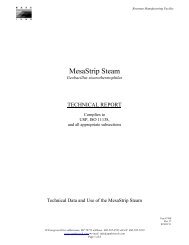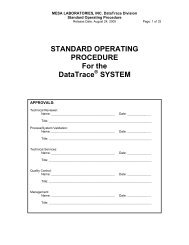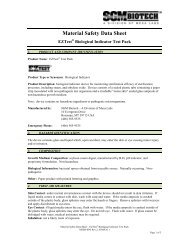Spore News Vol 10 No1 Organisms and their Uses in ... - Mesa Labs
Spore News Vol 10 No1 Organisms and their Uses in ... - Mesa Labs
Spore News Vol 10 No1 Organisms and their Uses in ... - Mesa Labs
You also want an ePaper? Increase the reach of your titles
YUMPU automatically turns print PDFs into web optimized ePapers that Google loves.
Bacillus atrophaeusBacillus atrophaeus is used <strong>in</strong> <strong>Mesa</strong> <strong>Labs</strong> BIs <strong>in</strong>tended for ethylene oxide, dry heat, chlor<strong>in</strong>e dioxide <strong>and</strong>ozone sterilization processes. B. atrophaeus is a mesophilic organism with an optimum growth temperaturerange of 30°C – 39°C. Resistance characteristics vary depend<strong>in</strong>g on BI configuration <strong>and</strong> sterilizationprocess. ISO 11138-2 requires an EO D 54-value of not less than 2.5 m<strong>in</strong>utes for a st<strong>and</strong>ard BI. ISO11138-4 requires a dry heat D 160-value of not less than 2.5 m<strong>in</strong>utes <strong>and</strong> a Z-value ≥ 20°C determ<strong>in</strong>edfrom three temperatures rang<strong>in</strong>g from 150°C - 180°C. USP only lists typical resistance characteristicswith these be<strong>in</strong>g: 2.5 m<strong>in</strong>utes – 5.8 m<strong>in</strong>utes for EO D 54-value <strong>and</strong> 1.0 m<strong>in</strong>utes – 3.0 m<strong>in</strong> for dry heat D 160-values. Currently, there are no resistance requirements listed for chlor<strong>in</strong>e dioxide. Table 2 displays BIsfrom <strong>Mesa</strong> <strong>Labs</strong> us<strong>in</strong>g spores of B. atrophaeus:Table 2: Biological <strong>in</strong>dicators conta<strong>in</strong><strong>in</strong>g B. atrophaeusBozeman FacilityOmaha FacilitySelf-Conta<strong>in</strong>ed EZTest EO ProTest <strong>and</strong> Pro<strong>Spore</strong>2Strips <strong>in</strong> Glass<strong>in</strong>eMESAStripMESAStrip-DualsMESAStrip-ClO 2<strong>Spore</strong> StripsComb<strong>in</strong>ed <strong>Spore</strong> Strips<strong>Spore</strong> Strip for ClO 2Custom/Micro Strips1 mm x 25 mm3 mm x 25 mm2 mm x <strong>10</strong> mm2 mm x 19 mm**2 mm x <strong>10</strong> mm*Custom Paper Discs 6 mm round 6 mm <strong>and</strong> 9 mm roundBorosilicate Discs * 7 mm roundApex ProductsSta<strong>in</strong>less steel ribbon<strong>and</strong> discsSta<strong>in</strong>less steel ribbon<strong>and</strong> discsIndustrial Use BIs Sta<strong>in</strong>less steel discs Steel discs, coupons, threads,wires, poly suturesProcess Challenge Device * ProL<strong>in</strong>eCultur<strong>in</strong>g SetsReleasat for GasReleasat for ClO 2DriAmpTSB w/Phenol Red <strong>and</strong> sporestripsReleasat for ClO 2DriAmp<strong>Spore</strong> Suspensions aqueous or ethanol aqueous or ethanol* not a st<strong>and</strong>ard product from this facilityPage 3 of 5
Bacillus subtilis 5230Bacillus subtilis 5230 is employed <strong>in</strong> low temperature steam sterilization processes <strong>and</strong> is a good choicefor customers who may have heat sensitive products that may be compromised by the time <strong>and</strong> temperatureof the st<strong>and</strong>ard 121°C steam sterilization cycles. A properly validated cycle is necessary for useof this organism for steam processes but is an excellent <strong>and</strong> reliable choice for low temperature sterilizationprocesses. B. subtilis 5230 is a mesophile with an optimum growth temperature range of30°C – 39°C. It can grow up to 56°C. Table 3 displays BIs from <strong>Mesa</strong> <strong>Labs</strong> us<strong>in</strong>g spores of B. subtilis5230:Table 3: Biological <strong>in</strong>dicators us<strong>in</strong>g B. subtilis 5230Bozeman FacilityOmaha FacilitySelf Conta<strong>in</strong>ed SterilAmp 5230 ProAMP 5230Strips <strong>in</strong> Glass<strong>in</strong>e MESAStrip <strong>Spore</strong> Strip<strong>Spore</strong> Suspensions aqueous or ethanol aqueous or ethanolBacillus pumilusBacillus pumilus is used <strong>in</strong> <strong>Mesa</strong> <strong>Labs</strong> BIs <strong>in</strong>tended for ioniz<strong>in</strong>g radiation <strong>and</strong> ultraviolet sterilizationprocesses. B. pumilus is a mesophilic organism with an optimum growth temperature range of 30°C– 35°C. No st<strong>and</strong>ards <strong>in</strong> ISO or USP exist regard<strong>in</strong>g resistance requirements for this species. Table 4displays BIs from <strong>Mesa</strong> <strong>Labs</strong> sites us<strong>in</strong>g spores of B. pumilus:Table 4: Biological <strong>in</strong>dicators us<strong>in</strong>g B. pumilusBozeman FacilityOmaha FacilityStrips <strong>in</strong> Glass<strong>in</strong>e MESAStrip <strong>Spore</strong> Strip<strong>Spore</strong> Suspensions aqueous or ethanol aqueous or ethanolCustom Paper Discs 6 mm round *Industrial Use BIs sta<strong>in</strong>less steel discs **not a st<strong>and</strong>ard product from this facilityIn addition to the commonly used organisms described above, <strong>Mesa</strong> <strong>Labs</strong> manufactures a variety ofspores that can be <strong>in</strong>tended for direct <strong>in</strong>oculation <strong>in</strong> customer product for validation purposes or for BImanufacture by the customer. The follow<strong>in</strong>g organisms are manufactured <strong>in</strong> aqueous or ethanol solutions:Bacillus subtilis 6633 – mesophilic organism, optimum growth temperature 30°C – 35°C. Commonlyused as an organism for media growth promotion test<strong>in</strong>g.Bacillus megaterium – mesophilic organism, optimum growth temperature 30°C – 35°C. A commonlyused organism <strong>in</strong> environmental <strong>and</strong> <strong>in</strong>dustrial research applications.Bacillus cereus - mesophilic organism, optimum growth temperature 30°C – 35°C. Commonly used <strong>in</strong>food <strong>in</strong>dustry research as this organism is known to cause food-borne illnesses. Very closely related toBacillus anthracis <strong>and</strong> used as a surrogate organism.Page 4 of 5
Clostridium sporogenes – mesophilic anaerobic organism, optimum growth temperature 30°C – 35°C.Commonly used as a surrogate to Clostridium botul<strong>in</strong>um <strong>in</strong> food <strong>in</strong>dustry sterilization processes <strong>and</strong> iscurrently be<strong>in</strong>g researched as potential bacteria to fight cancerous tumors.Bacillus smithii (formerly Bacillus coagulans) – <strong>Mesa</strong> <strong>Labs</strong> has found optimum growth temperature of48°C – 52°C <strong>and</strong> has observed growth up to 65°C for this organism. It is most commonly used for probioticpurposes.Bacillus thur<strong>in</strong>giensis – mesophilic organism, optimum growth temperature 30°C – 35°C. Most commonlyknown for its use <strong>in</strong> pesticides <strong>and</strong> as a surrogate for Bacillus anthracis.This overview of organisms <strong>and</strong> <strong>their</strong> applications <strong>in</strong> BIs illustrates what is typically used for st<strong>and</strong>ard<strong>in</strong>dustry practices. There may be times dur<strong>in</strong>g validation process development where an altogether differentBI <strong>and</strong>/or organism comb<strong>in</strong>ation may be needed. In addition to BIs, <strong>Mesa</strong> <strong>Labs</strong> offers contractstudies to help with development of sterilization studies <strong>in</strong> product <strong>and</strong>/or bioburden resistance determ<strong>in</strong>ations.<strong>Mesa</strong> <strong>Labs</strong> has an exceptional team of customer service <strong>and</strong> technical support that is happyto accommodate any questions or concerns that may arise <strong>in</strong> your sterilization/validation processes.Beth graduated from University of Montana with a B.S. <strong>in</strong> Microbiology <strong>and</strong> Medical Technology. Shehas worked for <strong>Mesa</strong> <strong>Labs</strong> (previously SGM Biotech) for n<strong>in</strong>e years hold<strong>in</strong>g positions <strong>in</strong> the BI productionlaboratory, Research <strong>and</strong> Development, <strong>and</strong> Contract Studies. Beth’s previous position was <strong>Spore</strong> LabSupervisor <strong>and</strong> currently she is Director of Laboratory Production.Page 5 of 5




